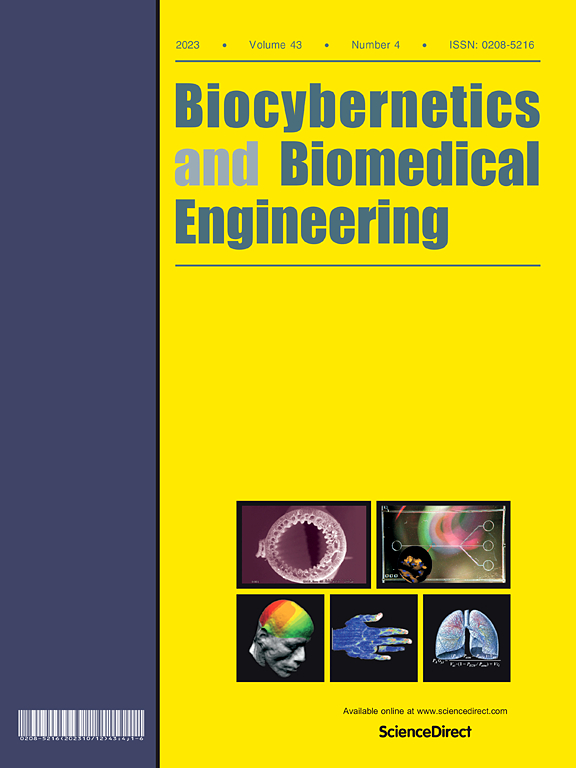Regional constraint consistency contrastive learning for automatic detection of urinary sediment in microscopic images
IF 6.6
2区 医学
Q1 ENGINEERING, BIOMEDICAL
引用次数: 0
Abstract
Diagnosing renal and urinary system illnesses usually entails analysing the sediment found in urine. The components in microscopic urine images are diverse and show high similarity, with low contrast due to noise, impeding the progress of automated urine analysis. In order to tackle this difficulty, we propose a region-constrained consistency contrastive learning approach for automated urine analysis. In the first stage, we tackle the complex overlap phenomena in microscopic urine images by innovating the Urine Sediment Paste (US-Paste) positive sample construction method based on supervised contrastive learning. This method uses label information to apply regional constraints and improves the performance of out-of-distribution detection. We also rebuilt the Global Guidance Module (GG Module) and the Enhanced Supervision Module(ES Module). The former improves contrast in urine sediment images by restoring important image details guided by an encoder–decoder structure, while the latter achieves strong feature consistency by combining the most pertinent feature responses from four sets of attention feature maps, which are further mapped via a projection network. In the second phase, we enhance the representations acquired in the initial phase by incorporating a linear classification layer. Our region-constrained consistency contrastive learning algorithm attained an average classification accuracy of 98.30%, precision of 98.33%, recall of 98.30%, and F1-score of 98.30% on the private dataset. Furthermore, in the public urine sediment dataset, the approach achieved an average classification accuracy of 96.19%, precision of 95.79%, recall of 96.19%, and F1-score of 95.94%. The public chromosomal dataset yielded an average classification accuracy of 95.46%, precision of 94.84%, recall of 95.47%, and F1-score of 95.15%. Our methodology surpasses the most advanced methods and demonstrates exceptional performance in urine analysis. This showcases the efficiency of our label-based regional limitations, the outstanding out-of-distribution detection performance of US-Paste, and the robust feature consistency achieved by the Guided Supervision Encoder (GS Encoder). This substantially enhances diagnostic efficiency for clinicians and significantly advances the progress of automated urine sediment analysis.
区域约束一致性对比学习在显微图像尿液沉积物自动检测中的应用
诊断肾脏和泌尿系统疾病通常需要分析尿液中的沉淀物。尿液显微图像中成分多样,相似度高,但由于噪声的影响,对比度较低,阻碍了尿液自动分析的进展。为了解决这一困难,我们提出了一种区域约束一致性对比学习方法用于自动尿液分析。在第一阶段,我们通过创新基于监督对比学习的尿液沉积物粘贴(US-Paste)阳性样本构建方法来解决微观尿液图像中复杂的重叠现象。该方法利用标签信息应用区域约束,提高了超出分布检测的性能。我们还重建了全局引导模块(GG模块)和增强监督模块(ES模块)。前者通过在编码器-解码器结构的引导下恢复重要的图像细节,提高了尿液沉积物图像的对比度,而后者通过结合四组注意力特征图中最相关的特征响应,通过投影网络进一步映射,实现了强特征一致性。在第二阶段,我们通过加入一个线性分类层来增强在初始阶段获得的表示。我们的区域约束一致性对比学习算法在私有数据集上的平均分类准确率为98.30%,精密度为98.33%,召回率为98.30%,f1分数为98.30%。此外,在公共尿液沉积物数据集中,该方法的平均分类准确率为96.19%,精密度为95.79%,召回率为96.19%,f1评分为95.94%。公开的染色体数据集平均分类准确率为95.46%,准确率为94.84%,召回率为95.47%,f1评分为95.15%。我们的方法超越了最先进的方法,在尿液分析中表现出卓越的性能。这展示了我们基于标签的区域限制的效率,US-Paste出色的分布外检测性能,以及引导监督编码器(GS编码器)实现的鲁棒特征一致性。这大大提高了临床医生的诊断效率,并显著推进了自动尿液沉积物分析的进展。
本文章由计算机程序翻译,如有差异,请以英文原文为准。
求助全文
约1分钟内获得全文
求助全文
来源期刊

Biocybernetics and Biomedical Engineering
ENGINEERING, BIOMEDICAL-
CiteScore
16.50
自引率
6.20%
发文量
77
审稿时长
38 days
期刊介绍:
Biocybernetics and Biomedical Engineering is a quarterly journal, founded in 1981, devoted to publishing the results of original, innovative and creative research investigations in the field of Biocybernetics and biomedical engineering, which bridges mathematical, physical, chemical and engineering methods and technology to analyse physiological processes in living organisms as well as to develop methods, devices and systems used in biology and medicine, mainly in medical diagnosis, monitoring systems and therapy. The Journal''s mission is to advance scientific discovery into new or improved standards of care, and promotion a wide-ranging exchange between science and its application to humans.
 求助内容:
求助内容: 应助结果提醒方式:
应助结果提醒方式:


